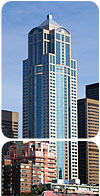ENDUSER: CONSTRUCTION/WOOD PRODUCTS: Revolutionizing the Present, Shaping the Future

Whether silicones are used in the construction of a hospital or home, playground or place of worship, their high-performance, technologically advanced polymers serve to protect, strengthen and preserve the integrity of buildings throughout neighborhoods all over the world. Because of their unique properties, in the event of a natural disaster or terrorist attack, silicones arm builders with an array of tools to minimize damage and maximize safety. Working on the integrity of both the structure and facade, silicones possess beneficial properties in four major areas that allow them to function in limitless ways. From initial construction to threat of destruction, silicone has the answers.
First, silicone is intrinsically resistant to heat, wind, moisture and chemicals. Silicone sealants and adhesives stand up to sun, salt, pollution and age better than other products on the market. Having these intrinsic resistances means that silicone sealants, adhesives and coatings slow down the erosion of buildings and building materials - even in the most extreme climates and under the most perilous conditions (e.g., hurricanes, earthquakes, bombings and criminal activity). To this end, silicones offer preemptive and enduring building protection from natural disasters, such as hurricanes, tornados, and earthquakes, with their natural strength and reliability. What's more, silicones extend the service life of exterior coatings, reducing the number of coats required without sacrificing color, coverage or protection. For example, silicone elastomers are applied to exterior building walls to form a flexible membrane that can handle the normal movements of seasonal thermal expansion and contraction, and prevent deterioration caused by wind, rain, and sunlight.
Second, silicones bond even the most diverse materials, such as concrete, glass, granite, marble, aluminum, steel and plastics. This translates into silicone's ability to bring strength and enhanced structural performance to building materials. Combined with its ability to withstand extreme elements, silicone's usage is more than ideal for increasing the lifespan of highways, airport runways, bridges, shipping yards, parking garages and residential streets. This ability also means that silicones can produce airtight seals that do not react with the materials sealed in or out of a container, such as liquids, gases or solids in chemical tanks, sewage and containment systems, or farm silos.
Because of these two properties, silicones have proven especially useful in improving structural safety in the event of violent storms, such as hurricanes and tornados, and, increasingly, from the threat of terrorism. Silicone sealants have the strength and long-term weatherability to anchor glass in its frame, preventing panes from blowing out completely under extreme conditions.
"Silicones also are a critical component used to create impact-resistant window systems that help prevent the glass from shattering inwards, minimizing the danger of flying glass in the event of an explosion," said Bill O'Brien, global manager for impact protective technology at Dow Corning.
Congressional reports indicated that flying glass was a major cause of loss of life in the Oklahoma City Bombing. "As a result, blast-resistant windows are now required by law in all new federal buildings," said Protecting People First Foundation Spokesperson Eric Cote. "Window safety testing and consulting services provided by silicone companies have been key in making many federal buildings safer in the event of similar attacks."
The performance of the Pentagon in the Sept. 11 terror attacks is a tribute to the value of silicone in protection applications. A high-performance silicone sealant is a key component in the window design credited with saving lives and reducing injuries in this instance. The glazing and curtain wall sealant was used in manufacturing all of the high-performance windows as part of the three-year Wedge I renovation that was just five days from completion when American Airlines Flight 77 dove into the building at about 350 mph and exploded. Despite the tremendous impact of the plane and the fire that was fed by the plane's fuel, the ‘web' created by the high-performance windows, steel columns, and geo-technical mesh held the building together for 35 minutes, giving many Pentagon employees, some located directly above the area of impact, time to escape.

Finally, integrating silicone with building materials provides architects and civil engineers additional design flexibility. Silicones are ideal for affixing materials and are used in expansion, construction, connection, and movement joints (such as in a bridge). The elastic joints provide the necessary give and take to hold components in place while absorbing natural shifting and movement. The combined strength and flexibility of silicone is critical to meeting impact-resistant glazing standards in residential and commercial window applications where silicone fastens the glass to the framing.
In commercial buildings constructed of large panes of glass, the silicone adhesive serves as the structural attachment and must perform under the structural load and environmental stresses. Impact-resistant structural silicone glazing is typically a critical factor in the performance of the entire window system. In residential window applications, silicone serves as both a sealant and an adhesive. The silicone sealant is paired with laminated glass or a safety window film to capture and prevent broken glass from becoming airborne. The silicone sealant provides a tight seal around the window and secures the film and window to the frame.
Whether a structure is facing daily fluctuations in temperature, humidity and wind, or it is up against a natural disaster that amplifies the potency of any of these elements while hurling debris, silicone's ability to be both flexible and strong ensures homeowners, builders, and community members alike that their edifices can - and will - endure all with the highest possible fortitude.
In summary, silicone offers both range in application and ease of use, all while decreasing costs and increasing safety for those who are building and using the final products in which silicone was used.
When it comes to creation and destruction, two things are inevitable in our ever-changing world: the need for more homes, bridges, schools, roads, and freeways will only continue to grow, while at the same time the promised, undated arrival of natural disasters will always pose a threat to what we have and what we build. With silicones, we are better equipped to create and more prepared for the unforeseen circumstances that lie ahead.
For more information on SEHSC, write to 2325 Dulles Corner Blvd., Suite 500, Herndon, VA 20171; phone (703) 788-6570; fax (703) 788-6545; e-mail sehsc@sehsc.com ; or visit http://www.sehsc.com .
Links
Looking for a reprint of this article?
From high-res PDFs to custom plaques, order your copy today!





